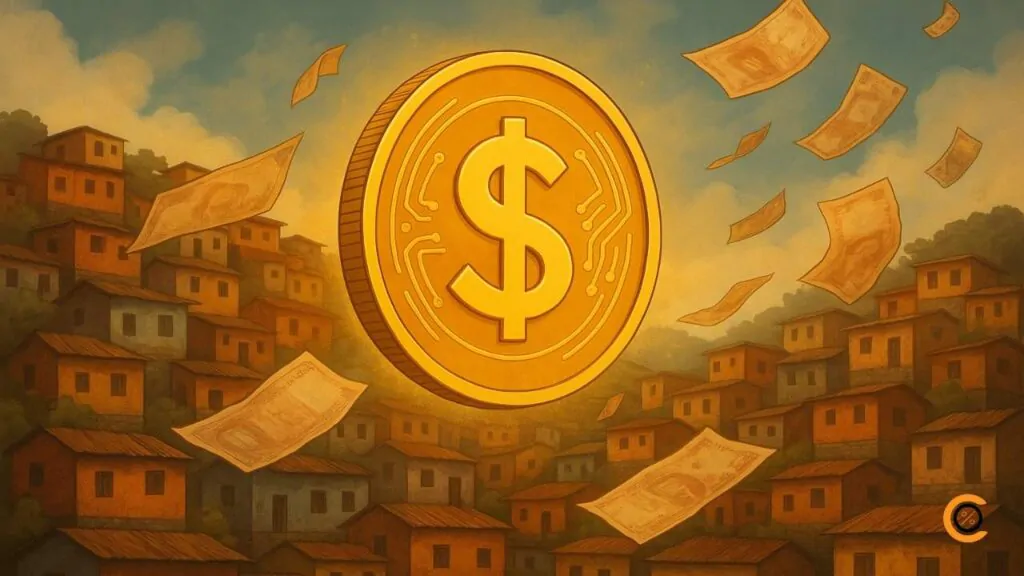- •Venezuela’s 229% inflation has rendered the bolívar nearly obsolete, with Binance dollars (USDT) now used widely for daily payments.
- •Exchange rate disparities; official, parallel, and Binance USDT, have made stablecoins the preferred standard for vendors and consumers.
- •Stablecoins accounted for 47% of crypto transactions under $10,000 in 2024, placing Venezuela 18th globally in crypto adoption.
Venezuela’s financial system has reached another breaking point. With inflation rising to 229% in 2025, the bolívar is no longer functioning as a reliable currency for daily use. People and businesses have turned to stablecoins, with Tether’s USDT, often referred to locally as “Binance dollars”, now embedded in everyday transactions. From paying for groceries and housing fees to covering salaries and vendor bills, USDT has effectively stepped in where the national currency has failed. This shift highlights how digital dollars are reshaping Venezuela’s economy under conditions of hyperinflation and strict capital controls.
Inflation and the Collapse of the Bolívar
Venezuela’s annual inflation rate reached 229% this year, further undermining confidence in the bolívar. The national currency, once central to commerce, is now largely absent in daily transactions. Hyperinflation, combined with government-imposed capital controls and a fractured exchange rate system, has made stablecoins a preferred alternative.
According to Mauricio Di Bartolomeo, a Venezuelan-born co-founder of crypto lending platform Ledn, people and businesses increasingly price goods in U.S. dollars and settle payments in stablecoins. He described USDT as not only a “better dollar” but also a “financial equalizer” that cuts across social classes, allowing both individuals and businesses to navigate the collapsing financial landscape.
Exchange Rates and Stablecoin Preference
The country currently operates under three different U.S. dollar exchange rates. The Central Bank of Venezuela (BCV) lists an official rate of 151.57 bolívars per dollar. In the parallel market, the rate climbs to 231.76, while on Binance the USDT rate sits at 219.62.
Vendors and consumers generally prefer the Binance dollar rate, which reflects stronger liquidity and consistency. This reliability has positioned USDT as the standard settlement tool for everything from small bodega purchases to mid-sized business contracts. Larger state-linked enterprises still rely on the BCV’s official rate, but the broader market has shifted toward stablecoins for practicality and trust.
Crypto Adoption in Numbers
The adoption of stablecoins is part of a broader crypto trend in Venezuela. Chainalysis data from the 2025 Global Crypto Adoption Index places the country 18th worldwide, and 9th when adjusted by population. In 2024, stablecoins represented 47% of all crypto transactions under $10,000, and total crypto activity in the country increased by 110% year over year.
This adoption shows how Venezuelans are using digital assets not as speculative investments but as everyday tools. Condo fees, security services, and even gardening expenses are now routinely priced and settled in stablecoins.
Capital Controls and Parallel Markets
Government-imposed restrictions on foreign currency have intensified the move toward digital alternatives. Official U.S. dollar allocations are often directed toward regime-connected firms, which resell them at higher rates in the parallel market. This has created a two-tiered economy where ordinary citizens turn to stablecoins to avoid the pitfalls of bolívar-based payments.
Di Bartolomeo explained that when people are forced to accept bolívars, they exchange them into USDT or dollars immediately, reflecting the lack of trust in the local currency. Reports also indicate that some Venezuelan banks and industries, including parts of the oil sector, have started to use stablecoins directly to bypass restrictions linked to U.S. sanctions.
A Regional and Global Trend
Venezuela is not alone in this transition. Other countries facing high inflation and currency instability, including Argentina, Turkey, and Nigeria, are experiencing similar shifts toward stablecoin usage. In each case, digital assets are becoming practical substitutes for weakened national currencies.
For Venezuela, the move to stablecoins has been more dramatic, reflecting years of economic turmoil and monetary instability. The situation illustrates how cryptocurrencies, particularly dollar-pegged stablecoins, can serve as financial lifelines in fragile economies.
Looking Ahead
As Venezuela’s annual inflation climbs to 229%, the bolívar has effectively disappeared from daily commerce. Binance dollars, or USDT, have taken its place as a stable and liquid alternative for millions of people trying to navigate the country’s financial challenges. While the bolívar remains the official currency, in practice, stablecoins now drive the economy. The rise of Binance dollars in Venezuela underscores how digital assets can become essential when traditional money loses its value.







